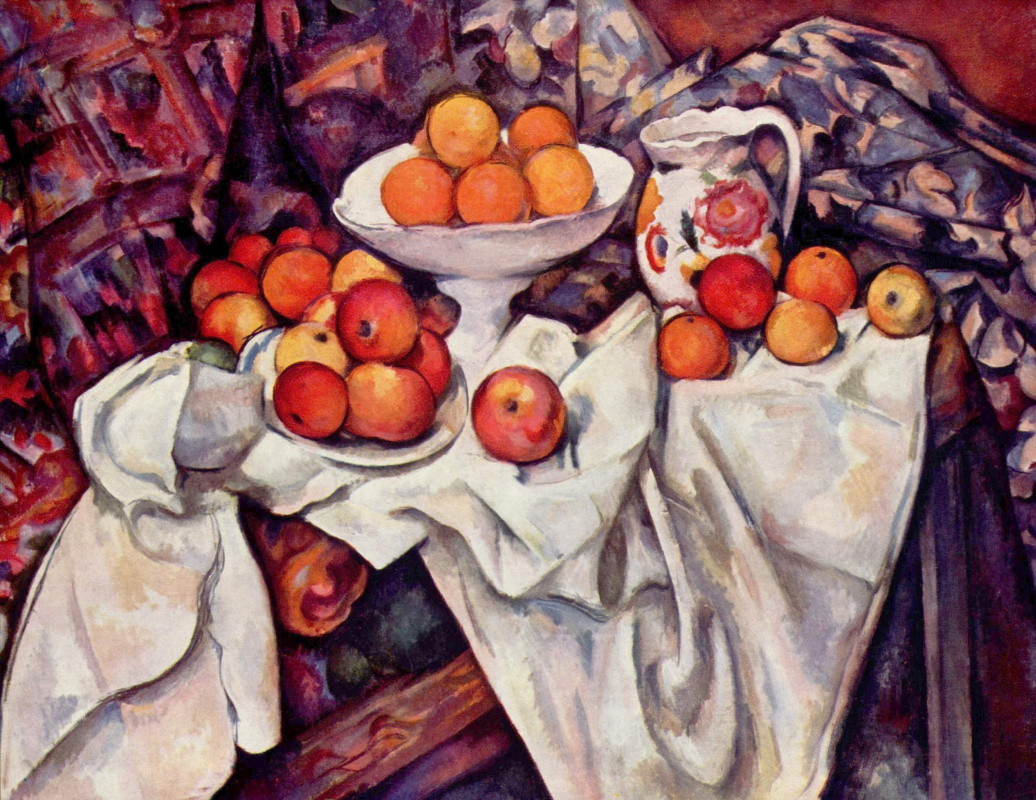log in
Enter site
Login to use Arthive functionality to the maximum
Apples and oranges
Paul Cezanne • Painting, 1900-th
, 73×92 cm
Description of the artwork «Apples and oranges»
In the biographical novel Lust for Life about Van Gogh, Irving Stone tells a funny and sad story of Cézanne’s apples. Père Tanguy, the owner of an art shop, not only sold on credit paints and brushes to poor artists, but sometimes bought their paintings so that they would not die of hunger. Once a man came to his shop to ask about the picture by Cézanne which was displayed in the window.
“A hundred francs? I wonder...” said the stranger. “For an unknown painter... I’m afraid that’s too expensive. I don’t think I can afford it. I was only prepared to spend about twenty-five.” The canvas was immediately taken out of the window and put before the customer.
“See, Monsieur, it is a big picture. There are four apples. Four apples are a hundred francs. You only want to spend twenty-five. Then why not take one apple?”
The man began to study the canvas with new interest.
“Yes, I could do that. It’s a fair offer. Just cut this apple the full length of the canvas and I’ll take it.”
This story is most likely a legend, but it is very exact and beautiful. Cézanne was understood by a handful of artists and a few amateur collectors, and loved even by less. If at present time, someone would desire to buy one apple by Paul Cézanne, this madman would still have to be a millionaire. Cézanne loved apples: they were stored for a long time and did not spoil, they did not move, did not scratch, did not sigh and did not break the intended composition. It was easy to put one or two sou coins under them — and place them on the tablecloth in the desired angle. Cézanne did not paint his wife, son, friends, or even himself as often as apples. “I want to hit Paris with an apple,” said the artist.
The most amazing thing that Cézanne achieved in his reclusive still lifes, that were being painted for long weeks in complete solitude, is the feeling of wholeness with the absolute geometric “irregularity”. He seemed to create its own perspective for each object, sending Euclid and the Salon to hell with its creaky criteria of the artwork correctness. In 1899, when Cézanne was painting apples and oranges, the clumsy salon judges had not yet recovered from the swoon caused by Manet’s insolence. His honorary exhibition in the sacred Salon halls would take place only six years later, and "Olympia" would be transported to the Louvre only in seven years. And now this crazy Provençal man is already throwing his apples into the last surviving canons of academic painting. He claims that he can see the rays that are emanating from each object, that “objects interpenetrate and do not stop living ... they understand each other as we do, through looks and words.” A little more time would pass and Picasso would call Cézanne his main and only teacher, whose paintings can be studied for years.
Author: Anna Sidelnikova
“A hundred francs? I wonder...” said the stranger. “For an unknown painter... I’m afraid that’s too expensive. I don’t think I can afford it. I was only prepared to spend about twenty-five.” The canvas was immediately taken out of the window and put before the customer.
“See, Monsieur, it is a big picture. There are four apples. Four apples are a hundred francs. You only want to spend twenty-five. Then why not take one apple?”
The man began to study the canvas with new interest.
“Yes, I could do that. It’s a fair offer. Just cut this apple the full length of the canvas and I’ll take it.”
This story is most likely a legend, but it is very exact and beautiful. Cézanne was understood by a handful of artists and a few amateur collectors, and loved even by less. If at present time, someone would desire to buy one apple by Paul Cézanne, this madman would still have to be a millionaire. Cézanne loved apples: they were stored for a long time and did not spoil, they did not move, did not scratch, did not sigh and did not break the intended composition. It was easy to put one or two sou coins under them — and place them on the tablecloth in the desired angle. Cézanne did not paint his wife, son, friends, or even himself as often as apples. “I want to hit Paris with an apple,” said the artist.
The most amazing thing that Cézanne achieved in his reclusive still lifes, that were being painted for long weeks in complete solitude, is the feeling of wholeness with the absolute geometric “irregularity”. He seemed to create its own perspective for each object, sending Euclid and the Salon to hell with its creaky criteria of the artwork correctness. In 1899, when Cézanne was painting apples and oranges, the clumsy salon judges had not yet recovered from the swoon caused by Manet’s insolence. His honorary exhibition in the sacred Salon halls would take place only six years later, and "Olympia" would be transported to the Louvre only in seven years. And now this crazy Provençal man is already throwing his apples into the last surviving canons of academic painting. He claims that he can see the rays that are emanating from each object, that “objects interpenetrate and do not stop living ... they understand each other as we do, through looks and words.” A little more time would pass and Picasso would call Cézanne his main and only teacher, whose paintings can be studied for years.
Author: Anna Sidelnikova



